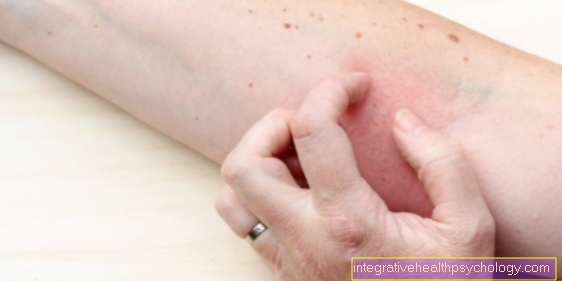Prick test
definition
The skin prick test is a frequently performed skin test that is used to determine a hypersensitivity reaction to certain substances.
A so-called type 1 allergy (immediate type) is determined. In the prick test, various allegenes are introduced into the skin with a lancet and the respective immune reaction is assessed.

When is a prick test done?
The prick test is always carried out if someone is suspected of having a so-called type 1 allergy.
This type of allergy includes very different allergies, which are sometimes widespread in the population. The prick test is therefore often used. These include, for example, allergies to insect toxins such as bees and wasps, but also many food allergies (nuts, soy, shellfish, etc.) and the widespread pollen allergy.
The prick test is used by many people to diagnose allergic asthma or hay fever (allergic rhinoconjunctivitis) known because it is often used there. In principle, however, it can also be carried out on suspicion in other situations. For example, this could be a suspicious reaction after eating food or an allergic reaction after an insect bite.
Drug allergies are excluded. Although these are often also part of the so-called type 1 allergy, one usually neglects such testing and simply switches to a tolerable drug.
You may also be interested in this topic: Allergy test
Prick test for hay fever
Hay fever is also known as allergic rhinoconjunctivitis in medical terminology. There are various allergens, such as pollen, that cause symptoms when inhaled. Since hay fever is a type 1 allergy, a prick test can be used to diagnose and identify the allergens. In young children, however, a blood test is preferable to the prick test, as this is better tolerated.
Read more on the topic: Symptoms of hay fever
Evaluation of the prick test
In a prick test, the sensitization to a certain substance, also known as an allergen, is tested. For this, up to 20 test solutions with different allergens can be applied to the skin using a lancet.
In order to be able to correctly evaluate the test afterwards, a negative and a positive control must be applied. The positive control contains histamine, which causes a wheal reaction. The negative control, on the other hand, contains saline solution and does not cause any skin reaction.
The prick test can be read after about 20 minutes. The doctor will judge whether there is a positive reaction based on the appearance of the skin. To do this, he compares each test solution with the positive and negative controls. If a wheal has formed in a test solution, this is to be rated as "positive". The positive result indicates that the test person is sensitized to this substance, for example pollen.
To assess the strength of the reaction, the diameter of the wheal is measured. The positive reaction ultimately only indicates sensitization and not an allergy. An allergy can only be spoken of when symptoms are present.
An example to illustrate this: The prick test shows a sensitization to pollen. If there are symptoms during the pollen count, for example in the form of hay fever, there is an allergy to pollen.
You might also be interested in: Allergy diagnostics
What do the numbers mean in the prick test?
The numbering in a prick test has the task of assigning the individual skin areas to the applied liquids.
As a rule, 15 to 20 different allergenic liquids are dripped onto the forearm during the prick test. These liquids are all transparent so that you cannot tell them apart. That is why every liquid has a number so that in the event of a positive skin reaction, conclusions can also be drawn about the allergen.
What can I tell by the size of the wheal?
The wheal size does not reflect the actual severity of the allergy.
For example, strong skin reactions in the prick test can be accompanied by an only mildly pronounced allergy. The other way around, it can also be that a certain allergen only shows a small skin reaction, but can be very harmful in everyday life.
If the prick test is negative, can one still have an allergy?
Even if the prick test is negative, there may be an allergy. The prick test shows a sensitization to various test solutions that contain common allergens. The prick test therefore covers different, common allergies. However, the test cannot cover every conceivable allergen.
Therefore, an allergy can be present even with a negative result. Furthermore, the prick test is only suitable for diagnosing a so-called type 1 allergy. However, there are also other forms of allergy in which other test methods, such as the patch test, are used.
An example of such an allergy would be allergic contact eczema, as occurs with a nickel allergy. If there is a suspicion of a certain allergy, for example to house dust mites, despite a negative prick test, the so-called intracutaneous test can be carried out. It is somewhat more accurate than the prick test and is particularly suitable for "weak" allergens such as house dust mites, which often do not produce a positive reaction in the prick test.
Also read: Allergy pass - who needs it?
Can you do a prick test while pregnant?
Allergy tests, including prick tests, should not be performed during pregnancy.
This is for the following reason: The prick test carries a certain, albeit low, risk of anaphylactic shock. Anaphylactic shock is the most serious complication of an allergic reaction and is an acutely life-threatening situation.
Although this complication is very rare, one should not take any risk with a pregnant woman that is not absolutely necessary. Other milder reactions, such as nausea, vomiting, a drop in blood pressure, and difficulty breathing, may occur with a skin prick test. These risks should also not be expected of a pregnant woman.
What role does histamine play in the skin prick test?
Histamine is the so-called positive control in the skin prick test.
Histamine is an endogenous tissue hormone that plays an important role in allergic reactions and also in the immune system.
If histamine comes into contact with deeper layers of the skin as a result of the prick test, it always triggers a skin reaction. This then turns red and the skin forms a wheal.
The histamine is used to check whether the skin shows any reaction to this messenger substance. If the positive control with histamine does not lead to a skin reaction, the result of the prick test can only be consulted with reservations. Histamine also plays a role in the other test substances used.
A classic skin prick test consists of a positive and a negative control, as well as a number of substances that are known to cause allergic reactions.
If a person is actually allergic to a certain test substance, a typical chain reaction is triggered on the skin area.
- First of all, the lancet pricks the liquid into a deeper layer of skin.
- There it is then recognized by defense cells, the mast cells.
- If there is now an allergy to the substance, the mast cells release histamine.
- The histamine in turn causes the blood vessels in this area of the skin to dilate and the typical reddening occurs.
- In addition, the widened blood vessels also become more permeable, so that fluid can escape into the surrounding tissue.
- This mechanism then creates the wheal, which can be perceived as a small skin swelling.
In addition to the desired skin reaction to histamine in the skin prick test, there is also a general histamine intolerance in food.
Find out more at:
- Histamine intolerance
- These symptoms can be used to identify histamine intolerance
What is the cost of a prick test?
The costs for a prick test are usually in double-digit range. If an allergy is suspected, however, the costs for the prick test are paid by both statutory and private health insurance.
Who does the prick test?
The prick test is carried out on an outpatient basis by clinics and medical practices that have the additional designation "Allergology" to lead. This designation is often found at Pediatricians, dermatologists, ENT and lung specialistsbecause the test is carried out particularly frequently in these areas. A prick test can entail certain risks and complications and is therefore only carried out by a doctor.
Can I do a prick test at home?
A prick test cannot and cannot be carried out at home. It is a common test that usually does not cause discomfort.
In very rare cases, however, there is a risk of anaphylactic shock. Since anaphylactic shock is a life-threatening situation that can be fatal in the worst case, the test must not be carried out alone. The risk is negligible, but it should not be taken.
You may also be interested in this topic: Allergic shock
Recommendations from the editorial team
- The allergy emergency kit
- Allergy diagnostics
- Symptoms of an allergy
- hay fever
- Allergy to bee venom
- House dust allergy
- Therapy of allergy






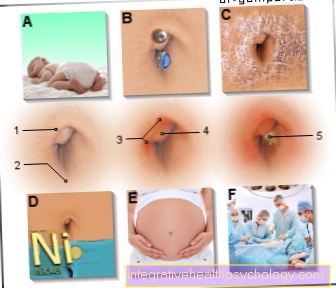
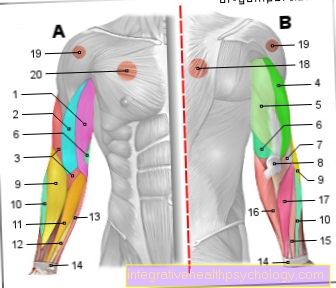



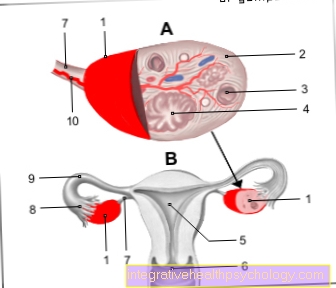




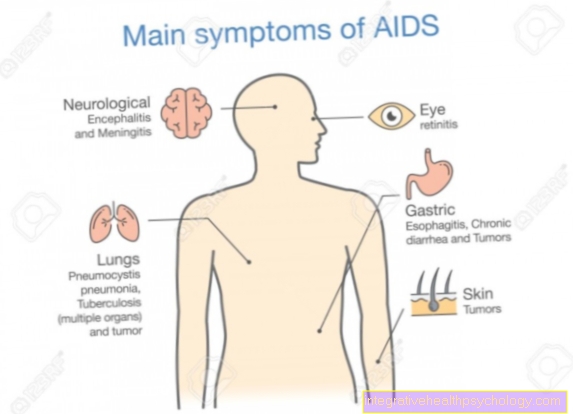


.jpg)







